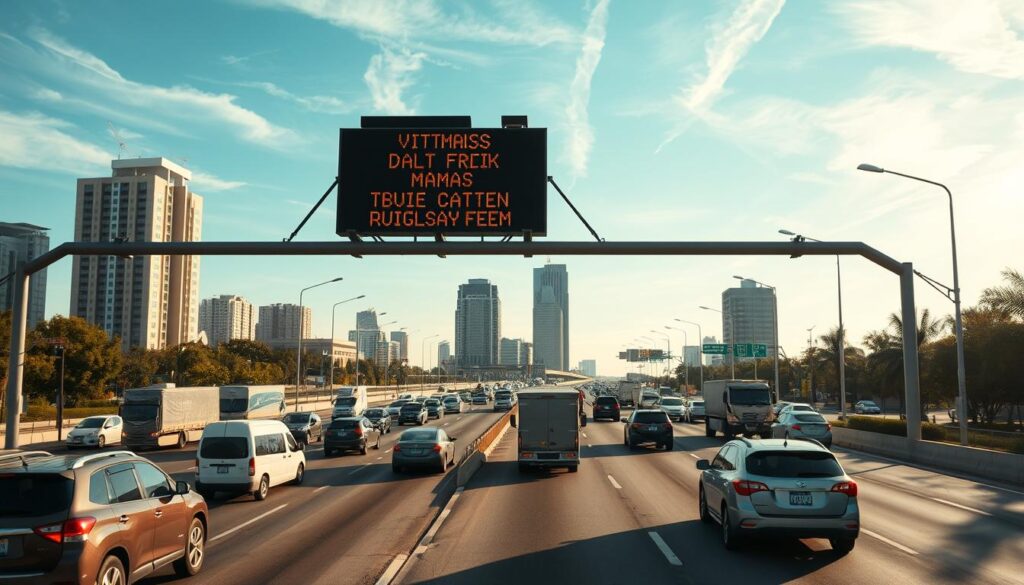Studies show that over 80% of people think Variable Message Signs (VMS) help a lot in avoiding traffic jams. These signs are key in managing city traffic. They help keep roads safe and traffic moving smoothly.
VMS signs give drivers quick updates on accidents, road closures, and other important info. This helps avoid big delays, like at railroad crossings. By using real-time data, these signs help drivers make better choices, making their commute easier.
The technology behind VMS makes traffic management more effective. It helps cities run better and keeps everyone informed. For more on how VMS works, check out this link.
Understanding Traffic Congestion Challenges
Traffic congestion is a big problem in cities. It happens when more cars try to use the roads than they can handle. This makes traffic slow and less efficient. Finding out why traffic gets stuck is key to fixing the problem.
Causes of Traffic Congestion
Many things cause traffic jams, mainly in busy places:
- Accidents on roadways that block lanes.
- Road construction leading to reduced capacity.
- Special events that temporarily increase vehicle volumes.
- Vertical Railroad crossings that lead to blockages.
- Unforeseen delays due to weather conditions.
These problems slow down cars and make trips longer, worst during rush hours. For example, long stops at railroad crossings make traffic worse, causing long lines of cars.
The Impact of Traffic Congestion on Urban Areas
More traffic means bad effects for cities. It leads to more pollution, higher gas prices, and a lower quality of life. Emergency vehicles also get stuck, which is dangerous.
Using smart traffic systems, like Variable Message Signs (VMS), helps a lot. These systems give drivers real-time updates. They are vital in fighting traffic jams and managing city traffic.
What are Variable Message Signs (VMS)?
Variable Message Signs (VMS) are key in modern traffic management. They give drivers real-time info. These signs use LED tech for clear visibility, helping to manage city traffic.
Types of VMS
There are several VMS types, including:
- Full Matrix Signs
- Fixed Variable Message Signs
- Portable Variable Message Signs
- Dynamic Message Signs (DMS)
Each type has its own function and use, meeting different traffic needs.
How VMS Operate
VMS get data from traffic cameras and sensors. They update messages in real-time. This helps drivers know about accidents, road closures, or weather.
Importance of Real-Time Information in Traffic Management
VMS improve traffic management by sharing real-time info. Studies show they help prevent accidents by alerting drivers early. They also help during bad weather by warning of dangers.
VMS also collect data on traffic, helping to make roads safer. For more on VMS and traffic management, check out this resource.
How VMS Signs Help Reduce Congestion in High-Traffic Areas
Variable Message Signs (VMS) are key in managing traffic and reducing jams. They give drivers real-time data to make smart choices during busy times. These signs are vital for making cities’ roads better.
Empowering Drivers with Real-Time Data
VMS signs give drivers updates to steer clear of traffic. They are placed 150 to 200 meters before roads split, making driving safer. Graphics on VMS are easier to understand than text, helping drivers react faster to traffic.
Studies show that timely and accurate info on VMS changes how drivers act.
Dynamic Management of Traffic Flow
VMS signs help control traffic flow by adjusting speed limits as needed. This lowers the chance of crashes. Radar sensors with VMS detect train speeds and presence, alerting drivers of delays.
This helps avoid sudden lane changes that can cause accidents, even in busy times.
Route Optimization and Diversion Strategy
VMS signs guide drivers to alternative routes during traffic jams. This spreads out traffic, avoiding congestion in cities. Full Matrix VMS have been shown to cut accident rates, even in bad weather.
With VMS, messages can be updated quickly. This ensures drivers get the latest on traffic issues and delays.

Benefits of Implementing VMS for Traffic Management
Variable Message Signs (VMS) bring many benefits to traffic management. They make roads safer and help with environmental issues and emergency alerts. VMS do more than just warn drivers; they help make traffic flow better and support green practices.
Improving Road Safety through Alerts
VMS alerts are key to safer roads. They tell drivers about dangers ahead, helping them stay safe. Cities with VMS see fewer accidents by 20-30%, showing their safety impact.
VMS also manage speed limits, cutting down on crashes. This makes driving safer for everyone.
Effective Communication During Emergencies
During emergencies, clear communication is vital. VMS are critical in sharing updates on road conditions and emergencies. They help prevent accidents and keep drivers informed.
Using VMS in emergency plans makes traffic management better.
Reducing Environmental Impact via Traffic Flow Optimization
VMS also help the environment. They improve traffic flow, cutting congestion by up to 15%. This leads to 10-15% less fuel use and fewer emissions.
This supports green urban planning goals. VMS help make transportation more efficient and eco-friendly.
Case Studies: Success Stories of VMS Implementation
Variable Message Signs (VMS) have made a big difference in traffic management. They have shown their worth in many places. These VMS implementation success stories show how they can make driving safer and better.
City A’s Traffic Management Strategy
In City A, VMS were set up at key spots. They gave drivers updates on traffic and road conditions. This cut down travel time and accidents, making roads better.
This traffic management case study shows how VMS can change cities for the better.
Highway B: Enhancing Traffic Flow During Special Events
Highway B is a great example of using VMS for special events. It changed speed limits and warned of dangers. This made driving safer and more efficient during busy times.
Such effective VMS strategies help move cars better and make trips smoother.
Lessons Learned from VMS Projects
Many VMS implementation success stories teach us important lessons. They show how messages, people’s backgrounds, and trust in signs affect driving. These tips help make VMS systems better for everyone.
Future Trends in VMS Technology
The world of traffic management is changing fast with new tech in Variable Message Signs (VMS). These systems are becoming key parts of smart cities. They help manage traffic better and make moving around cities easier.
Integration with Smart City Initiatives
Smart city VMS integration means creating networks that share info in real-time. This helps cities respond faster and manage traffic better. LED VMS signs will show the latest updates, helping to smooth out traffic and keep cities safe.
Role of AI and Machine Learning in VMS
AI is changing how VMS work. With machine learning, they can predict traffic and adjust messages on the fly. This makes traffic flow better and cuts down on jams. The future looks bright, with even more tech like IoT connecting devices for better communication.
Conclusion
Variable Message Signs (VMS) are a key part of modern traffic management. They help manage traffic by sharing real-time info. This makes driving smoother and safer.
VMS tell drivers about road conditions and closures. This helps reduce traffic jams and keeps roads safe. They are most useful in busy and accident-prone areas.
The future looks bright for traffic management enhancement with VMS. New tech like AI will make these signs even better. They will give more accurate and timely info.
As we move forward, VMS will play a big role in making our roads safer and more efficient. They will help set new standards for traffic solutions in cities.
Using VMS is a smart move for city planners and traffic managers. They do more than just manage traffic. They also improve safety and raise public awareness.
By improving these systems, we’re entering a new era in managing city transport. It’s important for everyone to support these innovative solutions. For more on VMS benefits, check out this resource.



